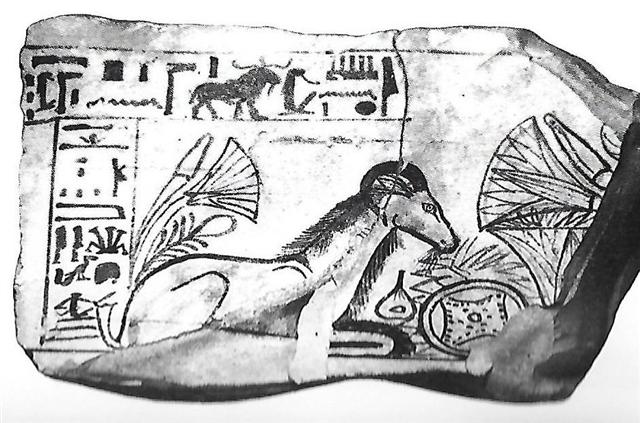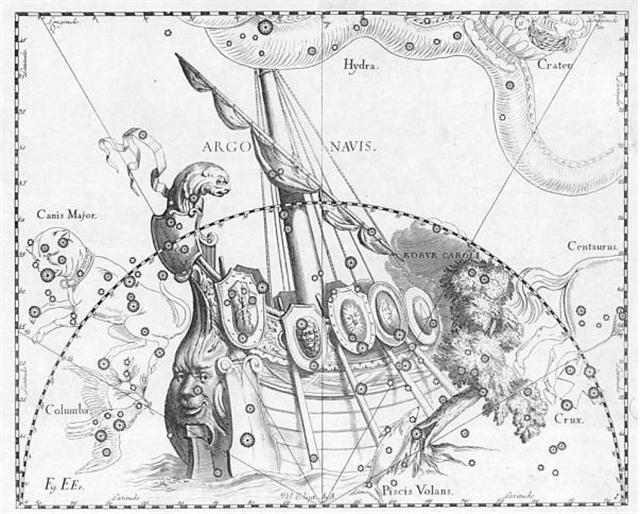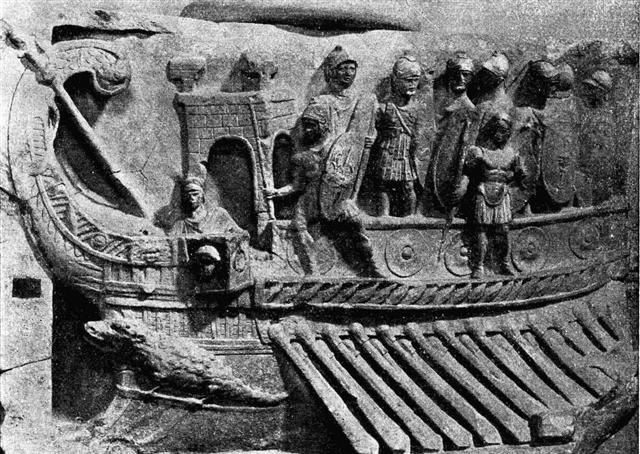Reading the stars from the outside of the celestial globe, as Heveilus did, means time will run from left to right, just as the flow of text in this sentence. Right ascension will increase towards the right, that was also the view of the rongorongo writers. Whereas for instance the Mayas had time moving from right to left, just as the flow in Arab texts. Only the 'tail' of Argo Navis may have been in full view in Roman times and therefore, in order to perceive the heads and tail picture with right ascension time running from left to right, I have here copied a mirror version of the coin of the year:
However, a significant part of the tail of Argo Navis had been truncated when the argonauts rowed as fast as they could between Scylla and Carybdis: "The Symplegades cut off, however, the ornament of the ship's stern (aphlastoio akra korymba), where the 'soul' of the ship was understood to dwell ..." (Hamlet's Mill) Possibly this loss of its 'soul' might explain why the stars of its bow were perceived to be so dim: ... The Ship appears to have no bow ... Aratos wrote: Sternforward Argō by the Great Dog's tail // Is drawn; for hers is not a usual course, // But backward turned she comes, as vessels do // When sailors have transposed the crooked stern // On entering harbour; all the ship reverse, // And gliding backward on the beach it grounds. // Sternforward thus is Jason's Argō drawn. This loss of its bow is said to have occurred ... when Argō pass'd // Through Bosporus betwixt the justling rocks - the Symplegades, the Cyanean (azure), or the Planctae Rocks at the mouth of the Euxine Sea. Yet Aratos may have thought it complete, for he wrote: All Argō stands aloft in sky. and Part moves dim and starless from the prow // Up to the mast, but the rest is bright; and it has often be so illustrated and described by artists and authors ... But according to Wikipedia the as above - the smallest of the Roman coins - is stated to illustrate the front of the ship, not its bright stern (which might still have been intact when Argo Navis was brought up into the sky as a configuration of stars). The Janus side of this coin of the year could therefore have represented its back side, a reversal of the normal order in the idea of head-and-tails. I can perceive a water jar in top center between the pair of Janus heads. And I therefore guess the top center entity above the war ship was its opposite, viz. a sign for no water (no softness). Such a dried up land sign seems to be the same as a variant of the henua type of glyph in the G text. It is concave to the right, as in the pair of henua glyphs in the days before the First Point of Aries respectively before Aldebaran:
Moreover, with Sheratan and Aldebaran both at 0h (in Roman times respectively in Babylonian times) the preceding glyph could depict an old 'person', slightly bent forward by age but tough enough to serve as a ram. It is placed above O in AMOR.
We can compare with Hevelius' description and then the location of this 'old bent person' appears to be approximately at the midsection of the mast:
Probably the statement in Wikipedia is wrong. The bright part of Argo Navis would serve best for the opposite side of the year compared to January. Moreover, Hevelius has depicted his Argo Navis very similar to the ship below. The curious little brick house could then have been there to protect the navigator, who ought to have been close to the stern where the direction forward was determined. The oars are in waiting position for the next stroke.
The nose of the crocodile agrees with the 'bulb' in the corresponding place on the as. Maybe the crocodile was a sign for what had been 'swallowed' at the Symplegades. The great Rishi Canopus (Agastya) swallowed the whole Sea it was said in Mahabharata.
Wilkinson comments on this Egyptian toy crocodile: by pulling on a string the child could make its jaws clash together in a naturalistic fashion. ... During the darkness and storm which followed, they all suffered intensely from cold and hunger; the rest bore their sufferings with stoical fortitude, but the red howling monkey uttered his anguish in such horrible yells that his throat swelled and has remained distended ever since; that, too, is the reason why to this day he has a sort of bony drum in his throat. Meanwhile Sigu from time to time let fall seeds of the palm into the water to judge of its depth by the splash. As the water sank, the interval between the dropping of the seed and the splash in the water grew longer; and at last, instead of a splash the listening Sigu heard the dull thud of the seeds striking the soft earth. Then he knew that the flood had subsided, and he and the animals prepared to descend. But the trumpeter-bird was in such a hurry to get down that he flopped straight into an ant's nest, and the hungry insects fastened on his legs and gnawed them to the bone. That is why the trumpeter-bird has still such spindle shanks. The other creatures profited by this awful example and came down the tree cautiously and safely. Sigu now rubbed two pieces of wood together to make fire, but just as he produced the first spark, he happened to look away, and the bush-turkey, mistaking the spark for a fire-fly, gobbled it up and flew off. The spark burned the greedy bird's gullet, and that is why turkey's have red wattles on their throats to this day The alligator was standing by at the time, doing no harm to anybody, but as he was for some reason an unpopular character, all the other animals accused him of having stolen and swallowed the spark. In order to recover the spark from the jaws of the alligator Sigu tore out the animal's tongue, and that is why alligators have no tongue to speak of down to this very day ... |




